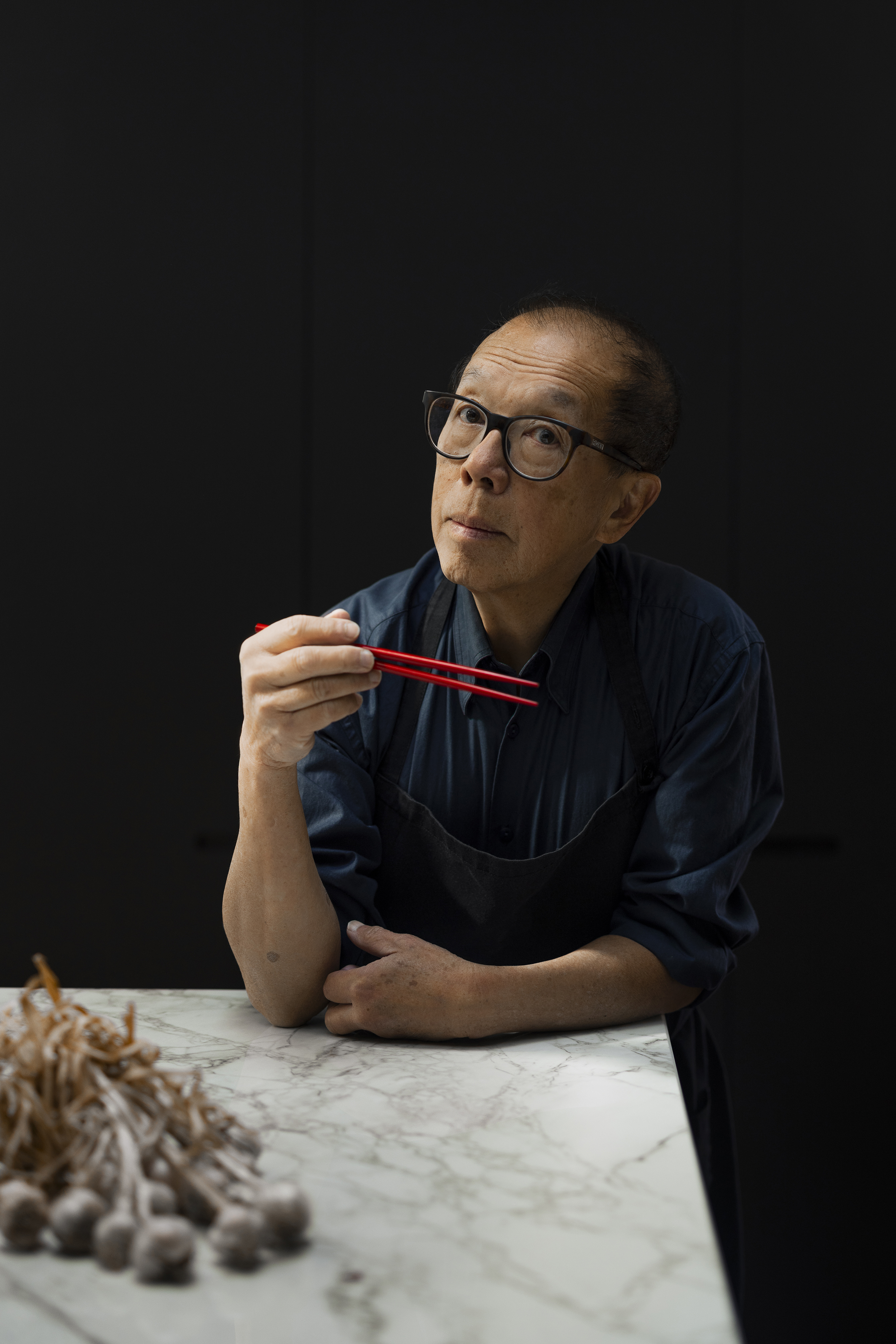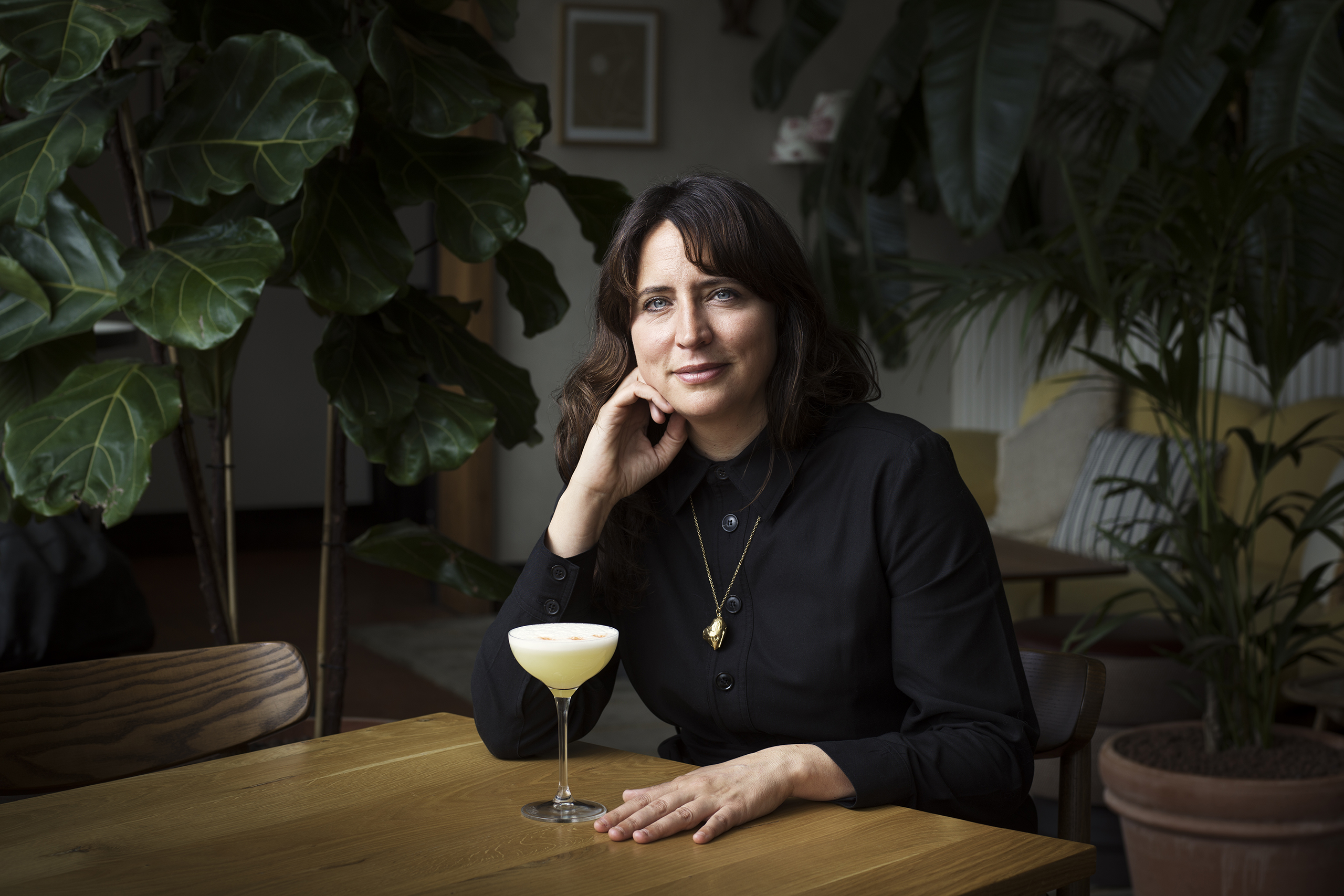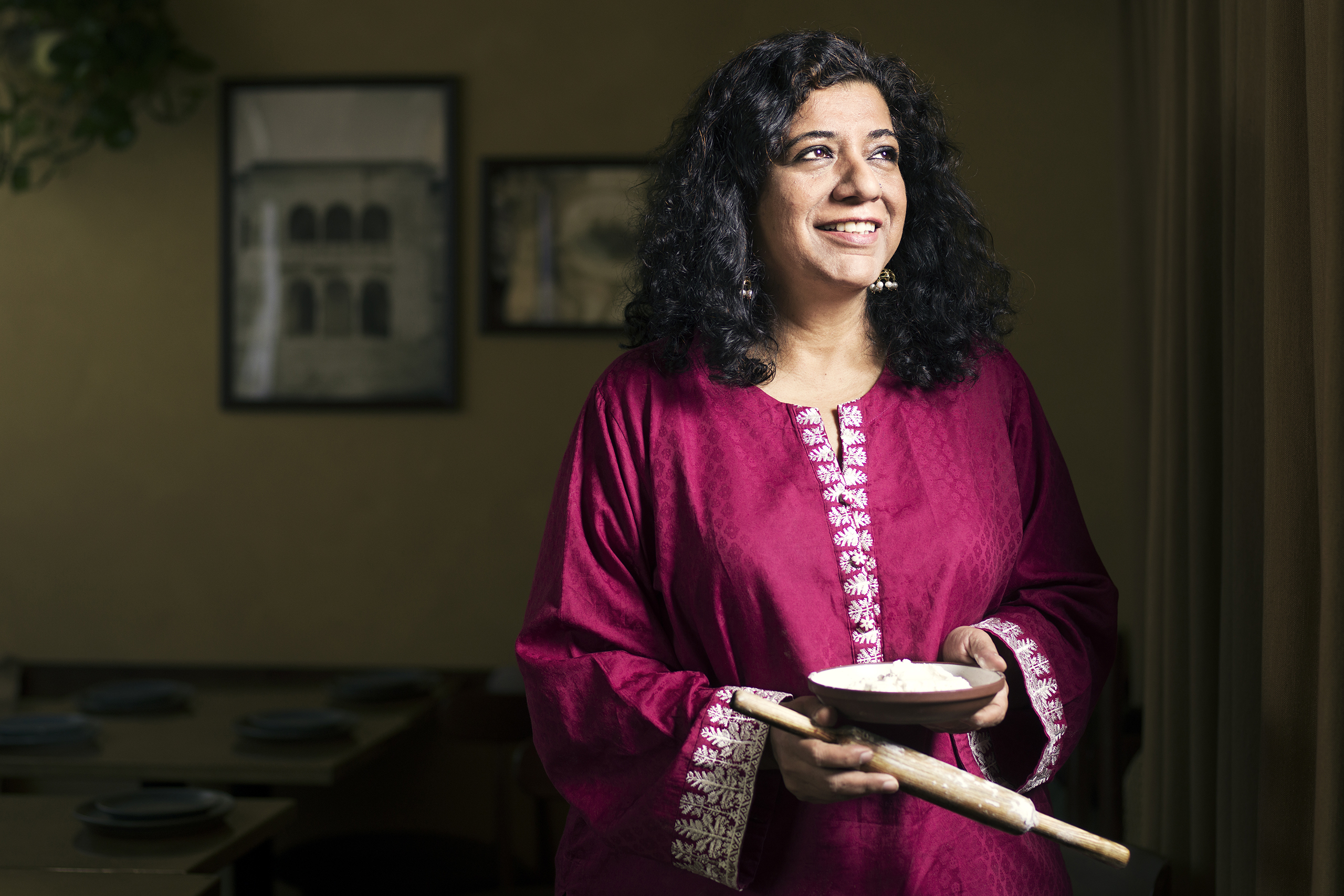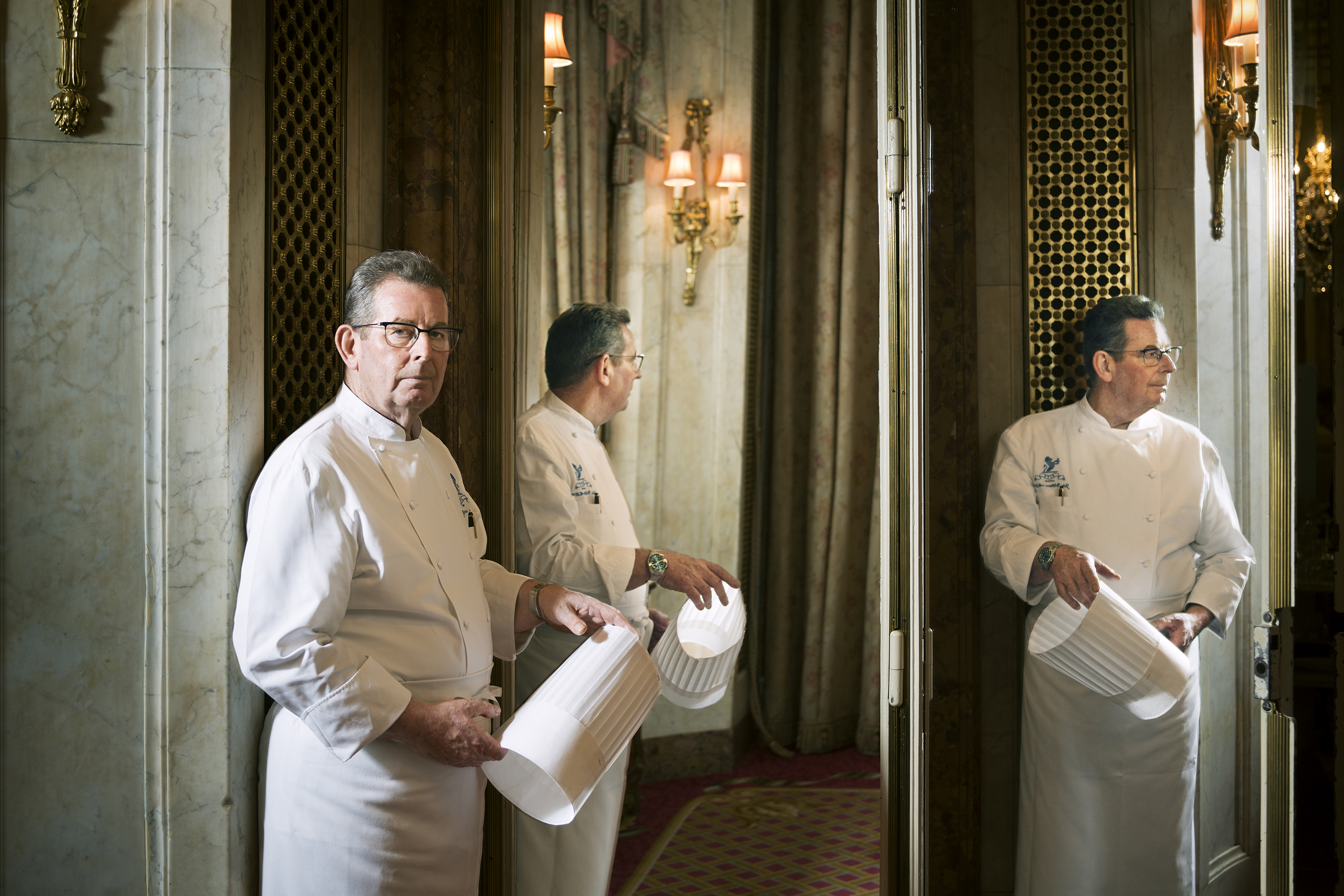Photographs by Pål Hansen
John Williams: the chef’s chef
It’s probably cooler to affect that you don’t care about awards, but John Williams, the executive chef of the Ritz in London, is not that person. “I’ve waited 50 years for this moment,” he said, as he took the stage at the Michelin Guide ceremony for Great Britain and Ireland in Glasgow in February. The Ritz had won its first star under his stewardship in 2017 and it had now been revealed that the restaurant had earned a second. Visibly emotional, he went on, “It’s so special – the Ritz is a special place. I thought we were forgotten.”
When we meet a few weeks later, the 66-year-old Williams is still flying. “Without doubt, I think it’s calmed me,” he says. His PA, Marta, sitting behind him in a small office overlooking the kitchen in the Ritz, can’t quite stifle a laugh and Williams joins her. “No, it was probably one of the most important things in my life. Not because you’re looking for awards. One of the things that I’ve looked for all my life, there’s a key word: respect. The respect of being good at it.”
On the wall behind Williams, there’s a framed letter from King Charles to congratulate him on the second star. “It is so well deserved,” the handwritten note reads, in messy cursive, “and a great tribute to your endless efforts in the culinary world.” Williams can’t stop smiling: “I got that two days later. You want to know, ‘Why do you love it?’ There you go.”
But Williams was correct to say the Ritz had been, if not “forgotten”, then perhaps underestimated as a food destination. For one thing, classic French, Escoffier-leaning cooking, of the style Williams specialises in, has not exactly been fashionable for a few years now: the buzz shifting to molecular then Nordic then smaller and lighter. (Williams describes some of the new trends in food as “fandangled”.) For another, excellence is expected from the so-called grand dame hotels. And you might eat a superb meal at the Ritz, but would you know that Williams, who has overseen the food offering since 2004, was behind it?
Cooking in a hotel is, in some ways, an ego-less business, which makes Williams the perfect candidate for the OFM’s chef’s chef. “You have to remember the difference between a restaurant chef and a hotel chef,” he says. “Generally speaking, a restaurant chef is wanting to cook the food he loves and believes in, and he wants to share that with guests. A hotel chef is one that wants to do that, but he’s only got that in the small percentage: 25% or 30% would be yours. He is actually working according to what the guests are telling him, which is slightly different.”
This is especially true in the Ritz. Williams accepts that every dish he sends out plays second fiddle to the neoclassical dining room, which the hotel’s founder, César Ritz, boasted contained so much bronze that the walls should almost collapse. “Fundamentally, the biggest thing that I say to everyone: the room is in charge of everything in that restaurant,” says Williams. “No chef in the world – and I still believe that – would be able to come into the Ritz and actually say, ‘Oh, this is me.’ You are only part of it.”
There are upsides, though. “In a restaurant you might get a president, if you’re lucky, in your lifetime,” says Williams, with a grin. “I’ve cooked for five or six presidents.”
Although Williams was kidding about 50 years, he distinctly recalls thinking, as a teenager, “I want to cook posh food”. He grew up in South Shields, on Tyneside, one of six children; his father was a fisherman, so there was good food, but not a lot of luxuries. “When I was a very young lad, I remember my dad coming home with his catch,” he says, his accent going a little more Geordie as he recalls it. “And we didn’t have a fridge, my mum used to put it in the bath and people would come to the back door and she’d be giving out bits: ’There’s yours … there’s yours … there’s yours …’ Then we would have fish for two days. That was it.”
Williams started cooking in a professional kitchen aged 14; he moved to London before his 17th birthday. Mentors were always important to him and he wanted to pay that back when he took leadership positions at the Berkeley, Claridge’s and the Ritz. In recent years, the Ritz has become a hothouse for the brightest young talents, among them Spencer Metzger, now executive chef at Jason Atherton’s Row on 5 in London, and Adam Smith, head chef of the Michelin-starred Woven by Adam Smith in Berkshire.
“John’s a true gentleman, and he’s the master of his craft,” says Metzger, who worked alongside Williams for 13 years. “He’s a chef from a very different era: he always wanted to be a great hotel chef. It’s amazing that the Ritz has been been able to come on a journey and progress and progress. Now it’s a destination restaurant, as well as a hotel. And it was very hard to break that mould, because it was always, ‘Let’s go to the Ritz for afternoon tea … Let’s go to the Ritz to celebrate Mum’s birthday.’ But now he’s managed to guide it and it’s a place of its own.”
For Metzger, though, Williams’s greatest legacy might just be his decency and the chefs he has inspired. “He’s not under the radar, because in the industry everyone knows him,” he says. “But he barely does any TV, doesn’t associate himself with anything else, apart from the Ritz. He’s just amazing, there’s no ego about him, it’s just all about the guests, all about the customer, and doing the right thing by the Ritz really. I don’t think there’s one person you could pick up the phone to who would ever say a bad word about him.”
Williams is spending more time on the golf course these days, but he has lost none of his ambition in the kitchen. He wants to keep making classic French food lighter, more modern. But, mainly, he wants to keep the 118-year-old Ritz “relevant” – a word he uses again and again. “The truth is, the day that I get tired, the day that they don’t want me, that’s the day,” he says, of retirement. “But at the moment, I’m very, very happy and see a future. Trust me, there’s only one other thing I would like …”
He points to the new plaque in his office that shows two Michelin stars and smiles, “Look, you see, it’s only got two!”
Tim Lewis

Tony Tan: the recipe whisperer
“What would happen if I thickened that leftover Thai duck curry and put it into dumplings?” It’s a typical Tony Tan thought. Which, in typical Tony Tan thinking might then be followed by: “What if I topped them with shavings of foie gras?” In the wrong hands this jazzy improvisation could go horribly wrong, but when you know the standards inside out and have fine control of your instruments, there’s a good chance it’ll produce something magnificent. It’s this particular set of skills, acquired over a long career, that have made Tan an authority not just on Asian food traditions but also a source of encouragement to anyone who believes that good things can be had when you colour outside the lines.
Professionally, he’s a former restaurant chef and sometime TV presenter, the author of two books, Hong Kong Food City and Tony Tan’s Asian Cooking Class, and principal of the Tony Tan Cooking School in Trentham, an hour’s drive north of Melbourne. Reputationally, he’s on the verge of national-treasure status in Australia, where he has lived since the 1970s, and is a cult figure among chefs worldwide
Helen Goh, a chef and friend of Tan’s of many years, invited him to the Ottolenghi Test Kitchen in London in February to demonstrate some dishes to the team. “I felt we could all learn from his deep knowledge and his authentic, uncompromising style of cooking.”
Tan made mung bean noodles from scratch and XO sauce on his first visit, and on his second he cooked Singapore chilli crab, and sambals with fresh torch ginger. His ability to bridge diverse food cultures, says Goh, is one of his gifts. “I’ve heard him draw parallels between culinary traditions that are genuinely illuminating. He has a respect for the cultural significance of food from all over the world and he communicates clearly and engagingly on the nuances of Asian cuisine.”
Over the years, Tan has worked with restaurants around the world on workshops and pop-ups – Planque in east London a recent example. In Australia, he has done deep dives into the likes of XO sauce for chefs in Melbourne chef Andrew McConnell’s restaurants, and has collaborated with Dave Verheul at the wine bar Embla (also in Melbourne) for years. When he talks to professionals, Tan says, he typically wants to help them gain a better understanding of ingredients (such as the torch ginger he brought to Ottolenghi), and to inspire them to use techniques more freely.
Tan is, in a word, particular. But while he has strong views on the sorghum spirit that separates good barbecue pork from great barbecue pork (mei kuei lu chiew; “it translates to ‘rose dew wine’ in English”) and the best cut of chicken for satay (thigh, skin on), he’s always up for trying a different way, and is led by his palate and his curiosity.
‘Seeing their faces light up with understanding is pure magic’
Steeped in multicultural society, he switches codes as readily as he flips between Mandarin, Bahasa Malaysia and English. He grew up in Kuantan, on the east coast of peninsular Malaysia. His parents were Hainanese. Dad ran a rest-house; mum didn’t speak a word of English but was fluent in the production of chutneys, mulligatawny, roasts and everything needed to serve British officials in south-east Asia in the first half of the 20th century. The Indian-Tamil neighbours inspired in Tan a passion for rotis, the Malays in the neighbourhood taught him how to cook beef rendang, and his Peranakan friends instilled in him an appreciation for buah keluak, a nut from a south-east Asian tree that’s toxic in its raw state and delicious (once the cyanide has been leached out) braised with chicken and tamarind.
Today, the table in his living room is covered with stacks of books. All the current it-books are there, but so is Lulu’s Provençal Table by Richard Olney. Bush Foods, Margaret-Mary Turner’s guide to the cuisine of the central desert people of Australia, sits next to Hilary Spurling’s Elinor Fettiplace’s Receipt Book, a go-to text on Elizabethan practical cookery.
But a conversation with Tan, or a dip into his own books, doesn’t leave you overwhelmed by the gap between his standards and your pantry. Instead you find yourself emboldened to cook with gusto and savour the web of food connections encircling the world. You will roast a chicken crusted in a mountain of salt. Why not grow your own water chestnuts? Of course murtabak pastries trace the path of Muslim migrants from Yemen to the East Indies. You can do it.
Nigella Lawson, writing about Tan’s most recent book, also cites his passion for learning and his capacity to think outside the square. “He knows when rules matter and when you can break free of them, which allows for joyful but respectful riffs on classical dishes.”
Back at the cooking school, he is seeing increasing numbers of students who want to connect with their Asian heritage. Sometimes it’s experienced cooks who want help decoding old family recipes; others have never had the chance to learn the basics. “Even something as simple as making Hainan chicken rice is daunting because they don’t understand when to plunge the bird into boiling water and how long to poach it.”
Professional or otherwise, making the connection for his students is what keeps Tony Tan motivated, 40 years into his work. “Seeing their faces light up with understanding when a cooking technique sinks in or when a flavour hits the right note is still pure magic.”
Pat Nourse

Jules Pearson: knows where you’re eating next
On her Instagram profile, Jules Pearson’s bio reads “fingers in” followed by a couple of pie emojis representing different aspects of the food world. If anything, it’s an understatement. In one of her guises, she is VP of food and beverage development at Ennismore, which owns the Hoxton and other hotel brands, and operates more than 500 restaurants and bars worldwide. It has been Pearson’s job to launch many of them, creating brand identities, luring in zeitgeisty chefs and making sure the restaurants hit the ground running.
In her spare time, she co-runs lifestyle website London on the Inside (LOTI). Launched in 2010, LOTI lists noteworthy things to do around London with a bias towards eating and drinking and an eye for nascent trends. Its print offshoot, Sausage Press, publishes fold-out guides to the capital’s best sandwich shops, natural wine bars and full English breakfasts.
Now, the 41-year-old has found another pie to stick a finger in. The hit Netflix documentary series Chef’s Table, which made superstars of chefs such as Massimo Bottura and Francis Mallmann, is expanding into what its founders describe as a “global culinary collective”, staging pop-ups and food experiences around the world. To manage the transition, they called on Pearson to help out. “My title is VP of activation,” she says, “but because it’s a tiny team with a startup mentality, I’m helping on pitches to clients, partnerships with interesting brands and creating pop-ups.”
‘It’s about being inquisitive and researching everywhere you go’
Pearson, who hails from a small town outside Middlesbrough, has a passion for food that’s taken her far from the council estate she grew up on. “Chefs and people in the food industry really respect her,” Chef’s Table showrunner Brian McGinn says, when asked what sets her apart. “There are very few people that can understand the craziness of a chef’s life, while bringing them on to exciting new projects.”
Selin Kiazim can identify with this. When Pearson first approached her a few years back, Kiazim was very much a “restaurant chef” who was wary of overtures from big hotels. “Other [hotel] people had approached me about doing projects but I found it very hard to click with them,” she says. But Pearson, with her “wealth of knowledge around restaurants”, put her at ease, and last year she helped Kiazim open the acclaimed Turkish restaurant Leydi inside one of Ennismore’s London hotels.
Pearson is taking a step back from her role at Ennismore after 13 years at the group, working only across new developments, which has allowed her to free up time for new projects. Has she always pushed herself this hard? “Yeah,” she says. “Well, not to get too deep, but my mother died when I was 18, and she had breast cancer for three or four years before. A friend of mine wrote a book saying that if you don’t deal with your grief, and you throw yourself into work, then you’re always saying yes and remaining busy so you don’t have to face that grief. And maybe there’s something in that.”
Pearson’s appetite for new food experiences appears undimmed. When I ask if she’s noticed any interesting trends recently, she throws out seven or eight examples, including an unusual approach to pricing at a cafe in Stoke Newington, where you’re encouraged to pay-as-you-feel, and “a Korean rice wine called makgeolli that I think is going to be huge”.
“It’s just about being inquisitive and researching everywhere you go,” she says of the skillset that makes her so valuable. And then there’s the formidable work ethic. “When people say to me, ‘How did you get there?’, I’m like: ‘Hard work, mate: weekends, evenings, non stop.’”
Killian Fox

Ryan Chetiyawardana: cocktail philosopher
Ryan Chetiyawardana is a name that provokes a certain awe in the drinks industry. He has won just about every bartending award going; his bars regularly feature on lists of the world’s best; and he has been ahead of most notable trends, from zero waste to no-alcohol, molecular techniques to outré ingredients. Think: beeswax old fashioneds, cloud sours and (personal favourite) diamond rickeys.
Yet the 40-year-old took the most roundabout route to bartending. His ambition, as the third child in a close-knit Sri Lankan family from Birmingham, was to become a doctor. So naturally, he opted to study art at Central Saint Martins, following a spell at catering college in his gap year. A year in, he moved to the University of Edinburgh to study biology. Then he switched again, eventually graduating with a degree in philosophy. “Cheffing, art, biology, philosophy, they’re all about people,” he says. “That’s what I was chasing.”
We’re talking in the blue midday repose of Lyaness in Sea Containers on London’s South Bank. This is now the centre of a mini empire that includes four bars in London, Amsterdam and Washington, DC and a recently produced YouTube series, Mr Lyan’s Taste Trips. Currently on the menu at Lyaness: a “funky, green, fruity punch” involving smoked camel milk and – of course! – hummingbird nectar.
‘Can a cocktail really have one ingredient? Yes!’
It was a student job at Bramble, an influential basement bar in Edinburgh, that pointed the way to Chetiyawardana’s future. “It was the first bar I worked in that didn’t have a theme of some kind,” he says. “The idea was simply that you look after people.”
Simon Difford, of Difford’s Guide – the internet’s central repository of bartending knowledge – says his talent was obvious. He recalls an outstanding silk stocking (tequila, cacao, grenadine, cream) that Chetiyawardana made for him. “Even then, he stood out due to the thought and care he put into his cocktails.”
Chetiyawardana opened his first bar in 2013, the pioneering White Lyan in Hoxton. He dispensed with perishable ingredients to lower waste, so there were no lemons and limes. He pre-batched all the ingredients and chilled them to optimal temperature – so there was no ice. There was also an excellent list of no- and low-alcoholic drinks, Chetiyawardana alert to the growing number of non-drinkers years ahead of the wider industry.
In conversation, it doesn’t take long for his philosophical side to emerge. When I ask him what his favourite cocktail is, he falls upon a neat dram of whisky. “You notice different notes that you might draw out in different cocktails,” he says. “But all of these things lead you back to the whisky in its neat form.”
Can a cocktail really have one ingredient, I wonder? “Yes!” he insists. “If it’s in the right glass at the right temperature and we’ve chosen it for a person in a particular mood. Cocktails to me are more about the consideration of all of the details than how many ingredients we’ve added.”
Ultimately, he says, it is about the act of sharing. “My mum was a phenomenal cook and we were all taught that if somebody has made something it’s an act of love and you should be grateful. And it brings everyone together. A cocktail is basically the top trumps of this. It’s so immediate. And it inherently feels special.”
Richard Godwin

Asma Khan: the changemaker
When Asma Khan stepped into what would become her first professional kitchen, she was surprised at how big everything was. Her restaurant, Darjeeling Express, had grown out of a supper club in her London home, where the food was cooked by Khan and women she knew. She was struck by a more profound realisation, too. “I thought, wow, this is so cold,” she says. “It doesn’t seem like this is a place where you can cook and make magic. I was not impressed by, as I have always called it, the Stainless Steel Empire.”
That’s not to say that hers isn’t a Stainless Steel Empire, of sorts. “It’s the norm, and it’s easy to clean,” she concedes. But that is about as conventional as Darjeeling Express gets. Khan talks solidly for 10 minutes about long hours, violence, substance abuse and stress in kitchens. “Who cares if you have five-star reviews? I want to know what’s happening behind your kitchen door. I want to know the food is being made without fear, that no one’s soul is being crushed.”
Serving dishes inspired by both Khan’s royal Mughlai ancestry and street food, she opened her permanent premises in 2017. She didn’t necessarily plan to have an all-female kitchen staff. “I already had these women working with me in the supper club from my house. Of course I was going to take them.” The women are home cooks, rather than trained professionals. “One of them has just turned 70,” she says. “And we have two grandmothers. These are not young women but, my god, they are just the absolute beating heart of the kitchen.”
‘I want to know the food in a restaurant is being made without fear’
Everybody told Khan that the restaurant would fail if she didn’t adapt. “They all said, you’ve got to have professionals in.” Naturally, she refused to budge. “How is it that a lifetime of cooking is unappreciated? How is it that women are not professionals because no one paid them? I never, ever doubted that it would work.”
Not only did it work, it has brought her attention. The mayor of London, Sadiq Khan, called on Khan to be part of a business forum to help guide London’s post-Covid economic recovery. “Asma is successful due to her passion and drive,” he says. “She has been a strong advocate for the whole industry and has been crucial in calling for better conditions and support for hospitality workers. She is one of the UK’s brightest culinary stars and a formidable presence in our hospitality sector.”
Most recently, King Charles and Queen Camilla visited Darjeeling Express to help chefs pack biryani in iftar boxes to send to charity.
A deep belief in helping others is integral to how Khan operates. In the early days of Darjeeling Express, for example, she would give the restaurant space over on Sundays to new chefs to host supper clubs or simply practise in the kitchen.
Mandy Yin, founder of Sambal Shiok in London, was one who took up the opportunity. “Asma has lent her support to me as a fellow female immigrant chef,” says Yin. “I have followed her example in supporting other women coming up through the ranks, especially those from more diverse backgrounds. Pay kindness forward, as what goes around, comes around.” It sounds like something Khan would say.
Rebecca Nicholson
